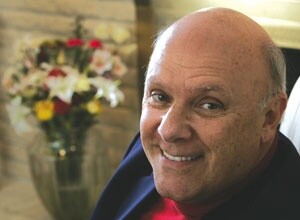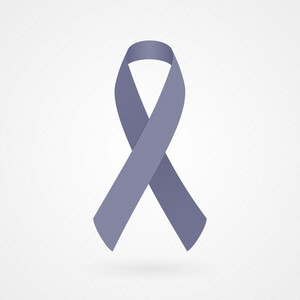- Adult Heart DiseaseDiseases of the arteries, valves, and aorta, as well as cardiac rhythm disturbances
- Pediatric and Congenital Heart DiseaseHeart abnormalities that are present at birth in children, as well as in adults
- Lung, Esophageal, and Other Chest DiseasesDiseases of the lung, esophagus, and chest wall
- ProceduresCommon surgical procedures of the heart, lungs, and esophagus
- Before, During, and After SurgeryHow to prepare for and recover from your surgery
April 3, 2017

In December 1999, I complained to my doctor about food getting stuck in my esophagus. She immediately sent me for an upper gastrointestinal (GI) series. The test came back with a brutal diagnosis—esophageal cancer. A follow-up endoscopy performed by a gastroenterologist confirmed the bad news; I had a stage III, 5-centimeter tumor of the gastroesophageal (GE) junction, which is where the esophagus and stomach meet.
I immediately used the internet to learn everything I could about esophageal cancer and was horrified by what I read. According to the statistics, I had about a 10% chance of living 5 years. The shock shattered my dreams of retirement, enjoying leisure time with my wife, and watching my grandchildren grow up.
But I was determined not to give into the fear fueled by those bleak statistics. At age 57, I felt physically strong enough to fight this cancer, but I needed a plan of action. I immediately scheduled a consult with a cardiothoracic surgeon at Memorial Sloan Kettering Cancer Center (MSKCC). I trusted that the MSKCC medical team would know how to fight back against this monstrous disease.
The surgeon was thorough in his examination. A computed tomography CT scan revealed that, in addition to the primary esophageal cancer tumor, I had enlarged lymph nodes in both lungs. A biopsy was necessary to determine if these were related to the esophageal cancer. I went into the hospital for 3 days in mid-January while the surgeon performed the procedure to determine if the cancer had spread to my lungs. The time spent waiting to find out my future felt unbearable. Should I prepare for my demise by getting my estate in order, or should I be planning to wage the fight of my life?
I was relieved when the biopsy results determined that the esophageal cancer had not spread to my lungs. Now that we understood the scope of the battle, the medical team at MSKCC put together a plan of attack that drew on the specialized skills of an oncologist, radiologist, and surgeon.
The first phase of the treatment plan called for a simultaneous course of chemotherapy and radiation. Cisplatin and Taxol, both chemotherapy drugs, would be administered 24 hours a day, 5 days a week for 6 weeks. During the same timeframe, I would receive 28 radiation treatments.
In preparation for chemotherapy, they placed a mediport in the upper part of my chest, below my shoulder on my right side. The drugs would be administered through a tube connected to a vein that led directly to my heart. Radiation treatments also required serious preparation. I needed to be “mapped” so that the radiologist could accurately focus the radiation beams. As part of this mapping process, they marked the area to be radiated by placing three tattoos in a straight line on my chest and two additional tattoos on my right and left sides. This gave the doctors the marks they needed to line up each radiation treatment. In order to make sure I was in the same position each time, they also made a cast of my body by asking me to lie on a bag full of molding material for what seemed like an eternity!
In addition to these procedures, I also underwent positron emission tomography (PET) scans, an endoscopic ultrasound (EUS), and multiple blood tests.
From my initial diagnosis in early December until all of the preparations were complete in mid-February, I worried about the delay in starting treatment. Was my tumor getting larger by the day? Was the treatment plan aggressive enough? Perhaps I should have had surgery first, then follow-up with chemo and radiation? Despite my fears, the MSKCC team assured me that the plan they had set was the right approach for me, and that the long preparation period would not have a major effect on the course of action.
I prayed they were right.

Esophageal Cancer Treatment Begins: Chemotherapy and Radiation
In February 2000, I began a new chapter in my life when I started esophageal cancer treatment. I was preparing for a 6-week course of simultaneous chemotherapy and radiation designed to shrink the size of the tumor. Despite my doctors’ assurances that this was the right course for me, I was not convinced that the treatment would work. As I faced the weeks of chemo and radiation, there were many days in which I was attacked by doubt.
Since we had decided that I would receive my esophageal cancer treatment at MSKCC, I needed to drive 100 miles round-trip each day, Monday through Friday, for the next 6 weeks to complete this phase of my journey.
I started the first phase of my esophageal cancer treatment on a Monday. My wife, Ginny, and I would go to the Rockefeller Outpatient Pavilion on 53rd Street in New York City where the doctors attached a needle to my mediport. I spent the first few hours receiving intravenous hydration, followed by the chemotherapy drug, Cisplatin.
When that process was complete, they attached a bag of the chemo drug, Taxol, to the pump around my waist and we were off to the Memorial Hospital location at 67th Street for the short radiation treatment. It actually took me longer to undress and get re-dressed than it took for the radiation treatment.
We drove home to New Jersey after the radiation treatment and for the rest of the day I would hear the pump cycling on and off. I kept thinking: I am injecting poison into my system to attack this monstrous cancer. I could only hope that the good cells in my body were strong enough to withstand the battle ahead.
Support from Family and Friends
The daily commute to New York City placed a heavy burden on Ginny. In order to give her some relief from the constant commute, a number of my friends, including my Knights of Columbus brothers, offered to take me in to New York each day for my treatments. We set up a schedule where Ginny and I would go in on Monday, Wednesday, and Friday, and my friends would take me on Tuesday and Thursday.
Esophageal Cancer Treatment Reactions
With the exception of the first day of treatment, my reaction over the 6 weeks was excellent. None of the other side effects I had been warned to expect ever happened. It made me wonder if the chemotherapy and radiation were actually working. I still had a problem swallowing solid food since the tumor continued to block the food from passing through my esophagus into my stomach. But the MSKCC team reassured me that everything was proceeding as planned.
After 6 weeks, doctors took another CT scan and endoscopic ultrasound. I was reassured to learn that, as a result of the chemotherapy and radiation, the 5-centimeter tumor blocking my esophagus had shrunk to 1-centimeter in diameter.
Rest and Recovery
Reaching the end of the simultaneous chemotherapy and radiation was a relief, but I was not yet at the end of my esophageal cancer treatment. I had earned a 6-week period of rest and recovery. When I regained my strength, I would tackle the final hurdle: surgery to remove what remained of my esophageal cancer tumor.
Listen to Bart describe his personal preparation before treatment.
Learn more about the Esophageal Cancer Education Foundation (ECEF).
Click here for more information about esophageal cancer.
Read about Bart’s surgery and recovery.
The opinions expressed in this article are those of the author and do not necessarily reflect the views of The Society of Thoracic Surgeons.

